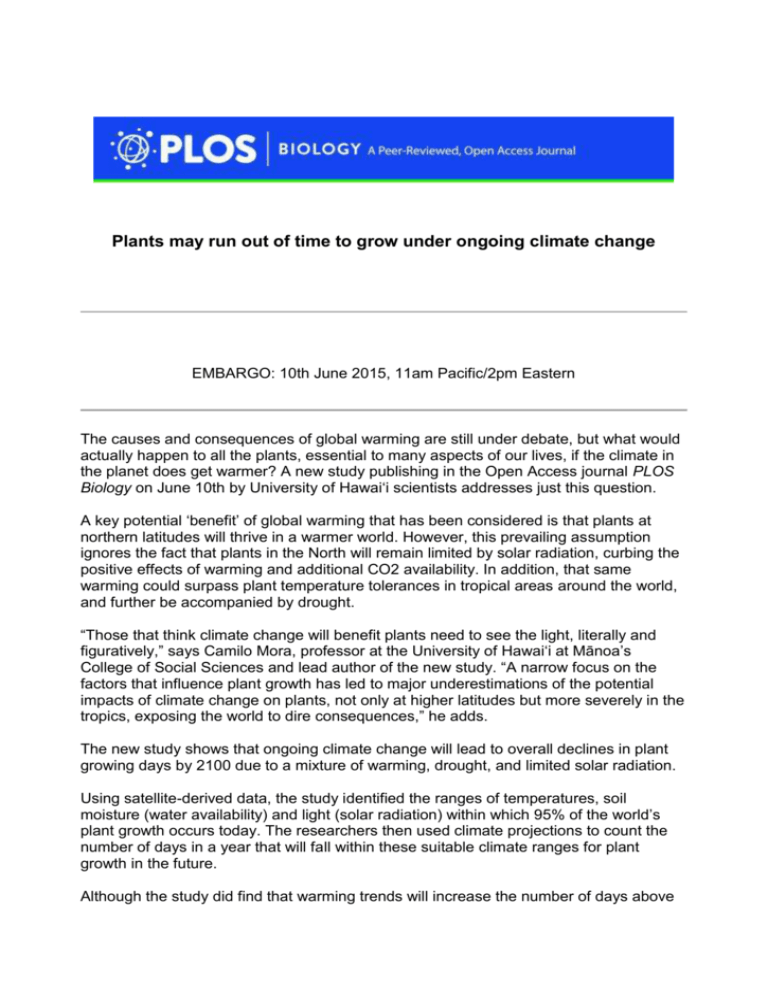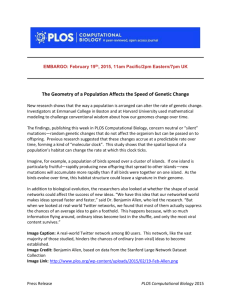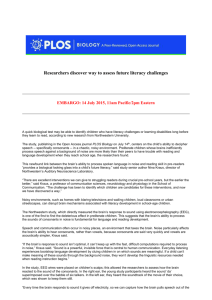Media Release
advertisement

Plants may run out of time to grow under ongoing climate change EMBARGO: 10th June 2015, 11am Pacific/2pm Eastern The causes and consequences of global warming are still under debate, but what would actually happen to all the plants, essential to many aspects of our lives, if the climate in the planet does get warmer? A new study publishing in the Open Access journal PLOS Biology on June 10th by University of Hawai‘i scientists addresses just this question. A key potential ‘benefit’ of global warming that has been considered is that plants at northern latitudes will thrive in a warmer world. However, this prevailing assumption ignores the fact that plants in the North will remain limited by solar radiation, curbing the positive effects of warming and additional CO2 availability. In addition, that same warming could surpass plant temperature tolerances in tropical areas around the world, and further be accompanied by drought. “Those that think climate change will benefit plants need to see the light, literally and figuratively,” says Camilo Mora, professor at the University of Hawai‘i at Mānoa’s College of Social Sciences and lead author of the new study. “A narrow focus on the factors that influence plant growth has led to major underestimations of the potential impacts of climate change on plants, not only at higher latitudes but more severely in the tropics, exposing the world to dire consequences,” he adds. The new study shows that ongoing climate change will lead to overall declines in plant growing days by 2100 due to a mixture of warming, drought, and limited solar radiation. Using satellite-derived data, the study identified the ranges of temperatures, soil moisture (water availability) and light (solar radiation) within which 95% of the world’s plant growth occurs today. The researchers then used climate projections to count the number of days in a year that will fall within these suitable climate ranges for plant growth in the future. Although the study did find that warming trends will increase the number of days above freezing at higher latitudes by 7%, these same locations will remain limited by light, a trend that has been missed by previous studies that focused on temperature alone. “Regions at higher latitudes will likely have less frost and snow on the ground in the future, but many plants will not be able to take advantage of those warmer temperatures because there will not be enough sunlight to sustain their growth,” says Iain Caldwell, a co-author of the study. The same warming that appeared to be a positive influence on plant growth at higher latitudes was found to be detrimental to plants in tropical regions, where conditions will become too warm and dry for most plant growth. Overall, the entire planet could see ~11% reduction in the number of days with suitable climates for plant growth, with some tropical regions facing a reduction of up to 200 days per year by 2100. “Although plants that have already adapted to live in extreme hot and dry conditions could fare well under a warming planet, the challenge will be for tropical agricultural and forest ecosystems to adapt to conditions that will likely surpass what they can currently tolerate,” says Jamie Caldwell, another co-author. Plants also sustain human societies by providing food, fiber, fuel, jobs and associated revenue. However, they can only deliver those things when climates are suitable for their growth. The new study goes further to assess where people will be hardest hit by the changes in the number of plant growing days. While some northern regions – predominantly in China, Russia and Canada – will likely experience improved climatic conditions for plant growth, approximately 2.1 billion individuals are highly vulnerable to the projected changes. These 2.1 billion people currently live in countries that depend heavily on plants for food, jobs and revenue, and have minimal capacity to adapt because they are poor, yet they could lose 30% or more of their current plant-growing period. “Climate change will have disproportional impacts on the poorest in the world,” says Micah Fisher, another co-author of the study. "Our analysis showed, for example, dramatic potential human impacts on the Sahel and on certain pacific islands. If subsistence farmers in the Sahel lose half of their growing days for plant crops, it will be hard for them to feed their families". On a more positive note, changes in suitable plant growing days were negligible under strong and moderate mitigation scenarios, suggesting that even modest reductions in emissions could prevent such drastic changes and their associated consequences for ecosystems and people. Please mention PLOS Biology as the source for this article and include the links below in your coverage to take readers to the online, open access articles. All works published in PLOS Biology are open access, which means that everything is immediately and freely available. Use this URL in your coverage to provide readers access to the paper upon publication: http://www.plosbiology.org/article/info:doi/10.1371/journal.pbio.1002167 Press-only preview: https://www.plos.org/wpcontent/uploads/2015/06/journal.pbio_.1002167.pdf Press-only preview of the related Synopsis: https://www.plos.org/wpcontent/uploads/2015/06/journal.pbio_.1002166.pdf Contact: Dr. Camilo Mora, +011- country code (57), area code (320) phone number (693 4305); cmora@hawaii.edu; (available from Colombia) Dr. Iain R. Caldwell, irc@hawaii.edu; (available from Hawai‘i) Jamie M. Caldwell, +1-808-236-7424; jsziklay@hawaii.edu; (available from Hawai‘i) Micah Fisher, +011- country code (62), city code (812) phone number (12154828) micahrf@hawaii.edu; (available from Indonesia) Citation: Mora C, Caldwell IR, Caldwell JM, Fisher MR, Genco BM, Running SW (2015) Suitable Days for Plant Growth Disappear under Projected Climate Change: Potential Human and Biotic Vulnerability. PLoS Biol 13(6): e1002167. doi:10.1371/journal.pbio.1002167 Funding: This paper was funded by a grant/cooperative agreement from the National Oceanic and Atmospheric Administration, Project R/IR-31, which is sponsored by the University of Hawaii Sea Grant College Program, SOEST, under Institutional Grant No. NA14OAR4170071 from NOAA Office of Sea Grant, Department of Commerce. The funders had no role in study design, data collection and analysis, decision to publish, or preparation of the manuscript. Competing Interests: The authors have declared that no competing interests exist. The views expressed herein are those of the authors and do not necessarily reflect the views of NOAA or any of its sub-agencies. UNIHI-SEAGRANT-JC-14-35. Disclaimer: This press release refers to an upcoming article in PLOS Biology. The release is provided by journal staff, or by the article authors and/or their institutions. Any opinions expressed in this release or article are the personal views of the contributors, and do not necessarily represent the views or policies of PLOS. PLOS expressly disclaims any and all warranties and liability in connection with the information found in the releases and articles and your use of such information. About PLOS Biology PLOS Biology is an open-access, peer-reviewed journal published by PLOS, featuring research articles of exceptional significance, originality, and relevance in all areas of biology. For more information visit http://www.plosbiology.org, or follow @PLOSBiology on Twitter. About PLOS: PLOS is a nonprofit publisher and advocacy organization founded to accelerate progress in science and medicine by leading a transformation in research communication. PLOS engages in Open Access advocacy, innovation, and publication of scientific research, making articles immediately available for everyone online, free of restrictions. The organization launched its first journal in 2003 and now publishes PLOS ONE, PLOS Biology, PLOS Medicine, PLOS Genetics, PLOS Computational Biology, PLOS Pathogens, and PLOS Neglected Tropical Diseases. PLOS is headquartered in San Francisco, CA with additional offices in Cambridge, UK.











